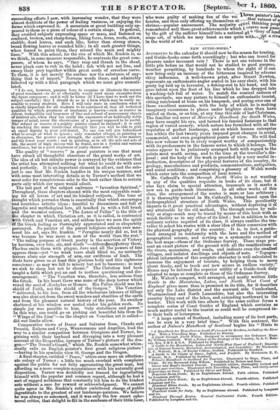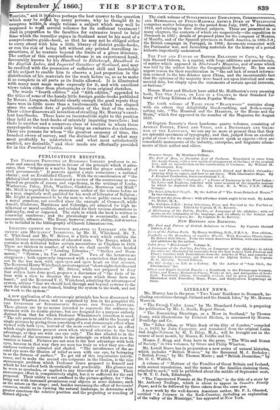NEW GUIDE-BOOKS.
ACCORDING to the calendar it should now be the season for touring, and Guide-books come forth accordingly; but who can travel for pleasure under incessant rain ? There is not one volume in the little pile before us that would not be studied to good purpose, weather permitting, by hundreds to whom the sight of it can now bring only an increase of the bitterness inspired by adverse skiey influences. A well-known print, after Stuart Newton, represents an enthusiastic angler seated in his easy chair, with his gouty leg laid up in lavender, a fishing-rod in his hand, and his gaze intent upon the float of his line which he has dropped into a washing-tub full of water. To match the comical sadness of this spectacle, one may picture to himself an enthusiastic tourist, sitting rainbound at home on his knapsack, and poring over one of these excellent manuals, with the help of which he is making imaginary excursions to places under brighter skies than have smiled on them, or on him, at any time this side of last Christmas. The familiar red cover of Murray's Handbook for South Wales, may have caught his eye, and turned his fancied footsteps to that region of varied scenery, which nature has furnished with all the requisites of perfect landscape, and on which human enterprise has within the last twenty years imposed great changes in social, commercial, and even geographical points of view. He will find this new volume to be in every respect worthy of companionship with its predecessors in the famous series to which it belongs. The routes appear to be judiciously arranged both with regard to the points most worth seeing, and to the time at the traveller's dis- posal; and the body of the work is preceded by a very useful in- troduction, descriptive of the physical features of the country, its geology, manufactures and products, communications, antiquities, and social condition ; and comprising a glossary of Welch words which enter into the composition of local names.
Mr. Cathrall's Guide through North Wales is not wanting
in any of the qualities requisite in books of its class, but it also lays claim to special attention, inasmuch as it marks a new era in guide-book literature. In all other works of this class, the arrangement of the routes is more or less arbitrary ; it is thoroughly natural in Mr. Cathrall's, being based upon the hydrographical structure of North Wales. This peculiarity imparts to it great practical advantages, without depriving it of any attainable by the old method. The through routes by rail- way or stage-coach may be traced by means of this book with as much facility as in any other of its kind ; but in addition to this ordinary service required of its class, it always enables the tra- veller to select his routes with a clear idea of their connexion with the physical geography of the country. It is, in fact, a guide-. book arranged in conformity with the laws and the method of geographical science, and guying as a systematic expositor of the best maps—those of the Ordnance Survey. These maps pre- sent an exact picture of the ground with all the ramifications of the rivers, mountains, and roads, and indicate even the smallest villages, and isolated dwellings and objects of note. "Topogra- phical information of this complete character is well calculated to increase the enjoyment of tourists, by helping them to move about freely, and to track out new scenes in endless variety." Hence may be inferred the superior utility of a Guide-book duly adapted to maps so complete as those of the Ordnance Survey.
Mr. Wakot's compact, well arranged, and neatly _written little
Guide to the Mountains, Lakes, and North West Coast of England gives more than is promised in its title, for it describes not only the Lake district and the seaward side Cumberland, Westmoreland and North Lancashire, but also the interesting country lying east of the lakes, and extending northward to the border. This work with two others by the same author forms a complete series of Coast Guides of England which contains as much matter useful to the tourist as could well be compressed in- to their bulk of letterpress. "A large extent of Scotland, including many of its best parts, can be seen in a very brief time." With this sentence, the author of Nelson's Handbook of Scotland begins his "Hints to
• A Handbook for Travellers in South Wales and its Borders, including the River Wye. With a Travelling Map. Published by Murray. A Guide through North 'Vales. Designed to accompany the Ordnance Maps. By William Cathrall. With a Notice of the Geology of the Country, by A. C. Ram- say, Esq. F.R.S. & G.S. Published by Stanford.
A Guide to the Mountains. Lakes and North-West Coast of England ; Descrip- tive of Natural Scenery, Historical, Archwological, and Legendary. By Mackenzie E. C. Walcott, M.A., of Exeter College, Oxford. Published by Stanford.
A Guide to the Coasts of Essex. Suffolk, and Norfolk. By Mackenzie E. C. Walcott, M.A. Published by Stanford.
Nelson's Handbook to Scotland for Tourists. Illustrated by Maps, Plans, and Views. By the Reverend John Wilson. Published by Nelson and Sons.
Oliver and Boyd's Scottish Tourist. Twentieth edition, thoroughly revised and in great part rewritten. Illustrated with Travelling Maps, Plans, and thirty-seven Engravings on Steel. Published by Oliver and Boyd. Practical Swiss Guide. By an Englishman Abroad. Fifth edition. Published by Longman and Co. Practical Paris Guide. By an Englishman Abroad. Fourth edition. Published Longman and Co. Practical Rhine Guide. By an Englishman Abroad. Fourth edition. Published by Longman and Co.
Practical Guide for Italy. By an Englishman Abroad. Published by Longman and Co.
Practical Through Routes. General Continental Guide. Fourth Edition. Published by Longman and Co.
Tourists," and. it in elves perhaps the best answer to the question which may be as fed by many persons, why he thought fit to compress within /a single volume a subject which may well be supposed to nftl several volumes for its sufficient treatment? Just in propostion to the faculties for extensive travel in brief time which the traveller enjoys in Scotland must be his need of a comprehensive guide-book, so that he may not be obliged either to carry about with him a little library of district guide-books, or run the risk of being left without any• printed travelling in- structions, if he venture beyond the limits of a given itinerary. The author of this compendious volume is an experienced hand, favourably known by his Handbook to Edinburgh, Handbook to the English Lakes, and Imperial Gazetteer of Scotland, and may be credited with the possession of sufficient skill and knowledge of his subject to enable him to observe a just proportion in the distribution of his materials for the work before us, so as to make it as complete in all parts as its limits allowed. It is illustrated with many neat maps made expressly for it, and with excellent views taken either from photographs or from original sketches. The words "fourth edition" and "fifth edition," appended to the titles of some of the handy little foreign guide-books published by Messrs. Longman, indicate clearly enough the good repute they have won in little more than a twelvemonth which has elapsed since the earliest date of publication of the first of the series. Their editor disavows all intention of rivalling Mr. Murray's excel- lent handbooks. These have an incontestible right to the position they hold as the text-books of minutely inquiring travellers ; but there is another and a numerous class of tourists to whom these encyclopedic volumes would only bring an embarras des richesses. These are persons for whom "the greatest economy of time, the broadest sweep of survey, and the distinctest limit of what may most profitably be undertaken and what most satisfactorily omitted, are desirable," and their needs are effectually provided for in the Practical Guides.



























 Previous page
Previous page